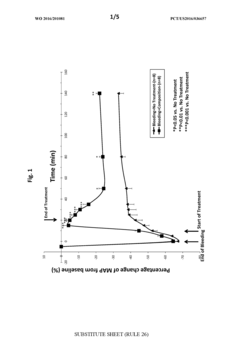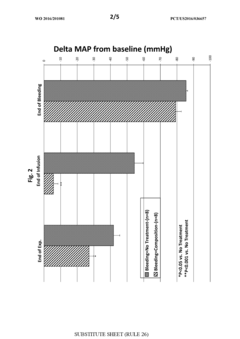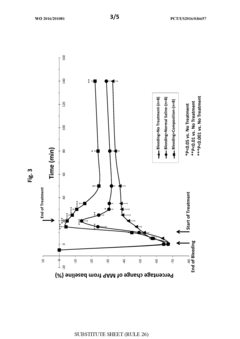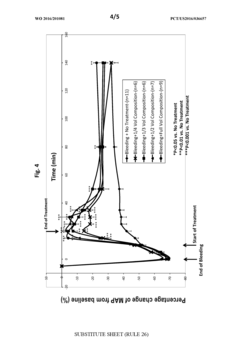Hypertonic Solutions: A Critical Component in Space Medicine
Space Medicine Background and Objectives
Space medicine has evolved significantly since the inception of human spaceflight, with the primary goal of ensuring astronaut health and performance in the challenging environment of space. The field encompasses a wide range of medical disciplines, including physiology, psychology, and pharmacology, all adapted to address the unique challenges posed by microgravity and radiation exposure. As space missions become longer and more ambitious, the importance of advanced medical solutions has grown exponentially.
Hypertonic solutions have emerged as a critical component in space medicine, offering potential solutions to various physiological challenges faced by astronauts. These solutions, characterized by their higher solute concentration compared to bodily fluids, have shown promise in addressing issues such as fluid shifts, bone demineralization, and intracranial pressure changes. The research into hypertonic solutions aims to develop more effective countermeasures against the adverse effects of long-duration spaceflight on human physiology.
The primary objectives of researching hypertonic solutions in space medicine are multifaceted. Firstly, there is a need to understand the precise mechanisms by which these solutions interact with the human body in microgravity conditions. This includes investigating their effects on fluid distribution, electrolyte balance, and cellular function. Secondly, researchers aim to optimize the composition and administration protocols of hypertonic solutions to maximize their therapeutic benefits while minimizing potential side effects.
Another crucial goal is to explore the potential of hypertonic solutions in mitigating the risk of vision impairment and intracranial pressure (VIIP) syndrome, a significant concern for long-duration space missions. By modulating fluid dynamics within the body, these solutions may help maintain proper intracranial pressure and preserve ocular health. Additionally, researchers are investigating the use of hypertonic solutions to combat bone loss and muscle atrophy, two of the most persistent challenges in space medicine.
The development of hypertonic solutions for space medicine also has implications for terrestrial healthcare. Insights gained from this research could lead to improved treatments for conditions such as traumatic brain injury, hypovolemic shock, and certain metabolic disorders. As such, the study of hypertonic solutions represents a prime example of how space medicine research can yield benefits both for space exploration and for healthcare on Earth.
Hypertonic Solutions Market Analysis in Aerospace
The market for hypertonic solutions in aerospace, particularly in space medicine, has been experiencing significant growth due to the increasing focus on long-duration space missions and the need for advanced medical interventions in microgravity environments. The demand for these solutions is primarily driven by their critical role in managing fluid shifts, preventing dehydration, and treating various medical conditions that astronauts may encounter during space travel.
The global space medicine market, which includes hypertonic solutions, is projected to expand at a compound annual growth rate (CAGR) of over 5% in the coming years. This growth is attributed to the rising number of space exploration missions, both government-led and private sector initiatives, as well as the increasing awareness of the physiological challenges faced by astronauts during extended periods in space.
Hypertonic solutions play a crucial role in addressing several space-related medical issues, including intracranial pressure management, fluid redistribution, and electrolyte imbalances. The market for these solutions is closely tied to the overall development of space medicine and life support systems for space missions. As space agencies and private companies plan for missions to the Moon, Mars, and beyond, the demand for specialized medical solutions, including hypertonic formulations, is expected to rise significantly.
The market landscape for hypertonic solutions in aerospace is characterized by a mix of established pharmaceutical companies and specialized space medicine firms. Major players in this sector are investing heavily in research and development to create innovative formulations tailored to the unique requirements of space travel. Collaborations between space agencies, research institutions, and pharmaceutical companies are becoming increasingly common, driving advancements in the field.
Geographically, North America dominates the market for hypertonic solutions in aerospace, largely due to the presence of NASA and numerous private space companies. However, emerging space programs in countries like China, India, and Russia are expected to contribute to market growth in the Asia-Pacific and Eastern European regions.
The market for hypertonic solutions in aerospace faces certain challenges, including the high cost of development and testing for space-specific applications, regulatory hurdles, and the limited number of space missions. However, these challenges are offset by the critical nature of these solutions in ensuring astronaut health and mission success, as well as the potential for spin-off applications in terrestrial medicine.
Current Challenges in Space Medicine Fluid Management
Space medicine faces significant challenges in managing fluids within the human body during extended periods of microgravity. The absence of gravity alters the distribution of bodily fluids, leading to a range of physiological issues that can compromise astronaut health and mission success. One of the primary concerns is fluid shift, where blood and other fluids move from the lower body to the upper body, causing facial swelling, nasal congestion, and increased intracranial pressure.
This fluid redistribution can lead to vision problems, known as Spaceflight Associated Neuro-ocular Syndrome (SANS), which affects a significant percentage of astronauts on long-duration missions. SANS is characterized by optic disc edema, globe flattening, and visual acuity changes, potentially causing long-term vision impairment. Managing this condition remains a critical challenge for space medicine practitioners.
Another major issue is the loss of plasma volume and red blood cell mass, which can result in orthostatic intolerance upon return to Earth. This condition makes it difficult for astronauts to maintain blood pressure while standing, increasing the risk of fainting and injury during re-adaptation to gravity. Developing effective countermeasures to maintain fluid balance and prevent these adverse effects is crucial for future long-duration space missions, particularly those to Mars.
Bone demineralization and muscle atrophy, partly due to fluid shifts and altered fluid dynamics, present additional challenges. These changes can lead to increased risk of fractures and reduced physical performance. Current exercise protocols and nutritional strategies have shown limited success in fully mitigating these effects, necessitating more advanced fluid management techniques.
The microgravity environment also affects the lymphatic system, potentially compromising immune function. Impaired lymph flow can lead to fluid accumulation in tissues and altered immune cell trafficking, which may increase susceptibility to infections and delayed wound healing. Developing methods to maintain proper lymphatic function in space is an ongoing challenge for researchers.
Lastly, the management of bodily waste fluids poses unique challenges in the confined environment of spacecraft. Current systems for urine and fecal collection are functional but far from ideal, especially for long-duration missions. Improving these systems to enhance efficiency, reduce mass, and potentially recycle water from waste is a critical area of research in space medicine fluid management.
Existing Hypertonic Solution Applications in Space
01 Hypertonic solutions for medical treatments
Hypertonic solutions are used in various medical treatments, including wound healing, reducing edema, and managing intracranial pressure. These solutions have a higher solute concentration than body fluids, which can draw fluid out of tissues and cells through osmosis. This property makes them effective in treating conditions where fluid reduction is necessary.- Medical applications of hypertonic solutions: Hypertonic solutions are used in various medical applications, including wound healing, reducing edema, and treating certain medical conditions. These solutions have a higher solute concentration than body fluids, which can help draw excess fluid from tissues and promote healing.
- Formulation of hypertonic solutions: The formulation of hypertonic solutions involves careful selection of solutes and their concentrations. Common ingredients include salts, sugars, and other osmotically active compounds. The precise composition is tailored to the specific application and desired therapeutic effect.
- Use in cell culture and preservation: Hypertonic solutions play a crucial role in cell culture techniques and preservation of biological materials. They can be used to control cell volume, maintain osmotic balance, and protect cells during cryopreservation processes.
- Applications in food and beverage industry: Hypertonic solutions are utilized in the food and beverage industry for various purposes, including food preservation, flavor enhancement, and texture modification. They can also be used in the production of sports drinks and other functional beverages.
- Environmental and industrial uses: Hypertonic solutions have applications in environmental remediation and industrial processes. They can be used for soil treatment, wastewater management, and in certain manufacturing processes where osmotic effects are beneficial.
02 Hypertonic solutions in cell preservation and cryopreservation
Hypertonic solutions play a crucial role in cell preservation and cryopreservation techniques. These solutions help protect cells from damage during freezing and thawing processes by controlling ice crystal formation and cellular dehydration. They are particularly useful in preserving biological samples, organs for transplantation, and reproductive cells.Expand Specific Solutions03 Hypertonic solutions for nasal and respiratory treatments
Hypertonic saline solutions are used in nasal and respiratory treatments to alleviate symptoms of various conditions. These solutions can help clear nasal passages, reduce congestion, and improve mucociliary clearance in patients with respiratory disorders such as cystic fibrosis, sinusitis, and allergic rhinitis.Expand Specific Solutions04 Hypertonic solutions in dialysis and fluid management
Hypertonic solutions are utilized in dialysis procedures and fluid management strategies. These solutions can help remove excess fluid from the body, maintain proper electrolyte balance, and manage conditions such as hypervolemia and hyponatremia. They are particularly useful in peritoneal dialysis and critical care settings.Expand Specific Solutions05 Hypertonic solutions in agriculture and plant science
Hypertonic solutions have applications in agriculture and plant science. They can be used to study plant cell responses to osmotic stress, improve seed germination, and enhance plant tolerance to environmental stressors such as drought and salinity. These solutions also play a role in developing strategies for crop improvement and stress resistance.Expand Specific Solutions
Key Players in Space Medicine Research and Development
The research on hypertonic solutions in space medicine is in an emerging phase, with a growing market driven by increasing space exploration activities. The global space medicine market is projected to expand significantly in the coming years. While the technology is still developing, several key players are advancing its maturity. Universities like Johns Hopkins, Zhejiang, and Peking are conducting foundational research, while companies such as Medtronic and Allergan are applying this knowledge to develop practical solutions. Research institutions like the Institute of Physical Chemistry of the Polish Academy of Sciences and the University of California are also contributing to the field's progression, indicating a collaborative approach to advancing this critical component of space medicine.
The Johns Hopkins University
Medtronic, Inc.
Innovative Hypertonic Solution Formulations for Microgravity
- The use of specific polymers (polyethylene glycol, glucose polymer, sucrose-epichlorohydrin copolymer) at concentrations not lower than their limit concentrations to generate osmotic pressure in hypertonic solutions.
- The concept of using polymer entanglement (at limiting concentrations) to create an effective hypertonic environment for macromolecule introduction into mammalian cells.
- The method's specific application for introducing macromolecules into mammalian cells, which is particularly relevant for space medicine applications.
- A composition comprising specific salts, natural or synthetic sugars, and a high molecular weight, non-ionic, hydrophilic polymer, which can be administered as a solid or liquid, effectively increasing intravascular volume and pressure, suitable for both therapeutic and prophylactic use, particularly in conditions like traumatic brain injury and hypovolemia, without causing renal impairment.
Regulatory Framework for Space Medicine Products
The regulatory framework for space medicine products is a complex and evolving landscape that requires careful navigation. As space exploration continues to advance, the need for specialized medical products and treatments becomes increasingly critical. Regulatory bodies such as NASA, ESA, and other national space agencies have established guidelines and protocols for the development, testing, and approval of medical products intended for use in space environments.
One of the primary challenges in regulating space medicine products is the unique environmental conditions they must withstand. These include microgravity, radiation exposure, and extreme temperature fluctuations. As a result, regulatory frameworks must account for these factors when evaluating the safety and efficacy of medical products designed for space use.
The International Space Station (ISS) serves as a key platform for testing and validating space medicine products. Regulatory agencies often require extensive testing on the ISS before approving products for use in long-duration space missions. This process involves rigorous protocols to ensure that products maintain their stability and effectiveness in the space environment.
Regulatory bodies also emphasize the importance of radiation resistance in space medicine products. Guidelines typically require manufacturers to demonstrate that their products can withstand the increased radiation levels encountered during space travel without degradation or loss of efficacy.
In terms of hypertonic solutions, regulatory frameworks often focus on their stability, packaging, and delivery systems. These solutions must maintain their concentration and effectiveness throughout the duration of a space mission, which can span several months or even years. Regulatory requirements may include specialized packaging that prevents evaporation or contamination in the unique space environment.
The approval process for space medicine products often involves collaboration between multiple regulatory agencies and space organizations. This international cooperation is essential for establishing consistent standards and ensuring the safety of astronauts from various nations participating in space missions.
As commercial space travel becomes more prevalent, regulatory frameworks are adapting to include considerations for private sector involvement in space medicine development. This includes guidelines for public-private partnerships and the potential commercialization of space-tested medical products for terrestrial use.
Continuous monitoring and post-approval surveillance are crucial components of the regulatory framework for space medicine products. Agencies require ongoing data collection and reporting on the performance and safety of approved products during actual space missions, allowing for rapid identification and response to any unforeseen issues.
Ethical Considerations in Space Medicine Research
The ethical considerations in space medicine research, particularly concerning hypertonic solutions, are multifaceted and require careful examination. One primary concern is the potential risks associated with testing new medical interventions on astronauts in the unique environment of space. The use of hypertonic solutions, while promising for addressing various physiological challenges in microgravity, may have unforeseen consequences that could jeopardize astronaut health and mission success.
Informed consent is a critical ethical issue in this context. Astronauts must be fully aware of the potential risks and benefits of participating in research involving hypertonic solutions. The confined and isolated nature of space missions may create a sense of pressure or obligation to participate, raising questions about the voluntariness of consent. Researchers must ensure that astronauts have the freedom to decline participation without fear of repercussions.
Privacy and confidentiality of medical data collected during space missions present another ethical challenge. The intimate nature of space travel and the public interest in astronauts' health status may conflict with individuals' right to medical privacy. Establishing robust protocols for data protection and defining clear boundaries for information sharing is essential.
The long-term effects of hypertonic solutions on astronaut health are not fully understood, given the limited opportunities for longitudinal studies in space. This uncertainty raises ethical questions about the balance between potential immediate benefits and unknown future risks. Researchers must carefully weigh the need for scientific advancement against the duty to protect astronaut well-being.
Equitable selection of research participants is another ethical consideration. The limited pool of astronauts and the specific physiological requirements for space travel may lead to selection biases. Ensuring diverse representation in research while maintaining mission safety standards requires careful consideration.
Lastly, the ethical implications of applying findings from space medicine research to Earth-based healthcare must be considered. While discoveries in space medicine may lead to breakthroughs in treating terrestrial conditions, the unique environment of space may limit the generalizability of results. Researchers must be cautious in extrapolating findings and transparent about the limitations of their studies.



